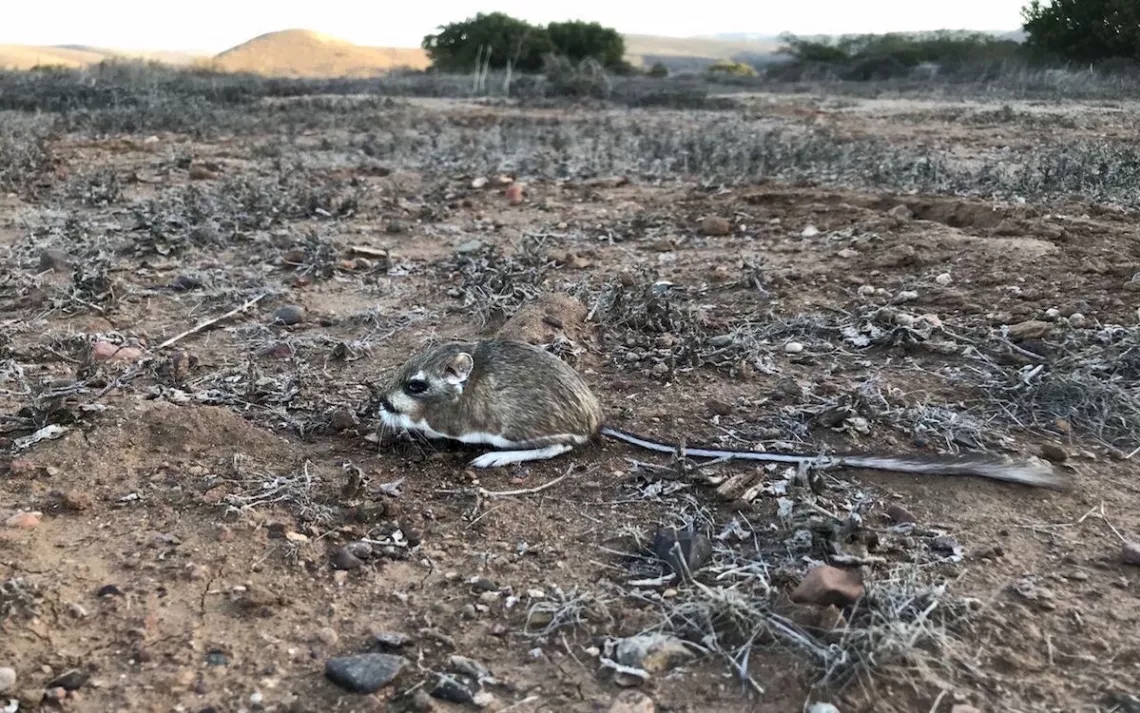“Extinct” San Quintín Kangaroo Rat Still Exists
The small mammal is making a comeback in Baja California

Photo courtesy of the San Diego Natural History Museum/Sula Vanderplank
At dusk on July 3, 2017, San Diego Natural History Museum mammalogist Scott Tremor set up a few live traps in some abandoned agricultural fields in Baja California, Mexico. With Sula Vanderplank, a botanist and research associate at the museum, and several graduate students in tow, he was there to conduct a broad survey of the flora and fauna in the area. He was also quietly hoping to catch a rarity: the San Quintín kangaroo rat, a small mammal that hadn’t been seen alive in over 30 years, considered extinct. “I’ve always wanted to look for this animal that people told me was extinct,” Tremor said. “I never believe that when people say it.”
Before dawn the next morning, Tremor checked on the traps and found pay dirt: a San Quintín kangaroo rat munching away on some dried oatmeal. “Without a doubt, it was very large. It was shocking.”
The San Quintín kangaroo rat was last seen in 1986 and was listed as endangered by the Mexican government in 1994. It is currently on the International Union for the Conservation of Nature Red List for critically endangered species.
The animal is larger than its kangaroo rat cousins, with large eyes and a tail longer than the length of its body plus a tuft of hair on the end. It is slightly feistier as well. Kangaroo rats are generally seen as gentle and calm creatures, but the ones Tremor and Vanderplank found are able to kick their way out of their hands. “They are very different in the rodent world than what many people would consider a rat,” Tremor said.
The species was once seen as an example of modern extinction due to agricultural conversion, according to a news release by the museum on the initial finding. In the past few decades, San Quintín, 118 miles south of Ensenada, has become a major agricultural hub, converting huge areas of native habitat into fields and hot houses for tomatoes and strawberries.
Tremor’s Fourth of July find was the first of several individual rats spotted in the area, and the prospects of a growing population are looking up—partly due to the conservation efforts of Terra Peninsular, a nonprofit land trust that owns and manages the Valle Tranquilo Nature Reserve and the Monte Ceniza Natural Reserve in San Quintín Bay, where the first sightings took place. They are deserted spaces, which were heavily impacted by agriculture and subsequently abandoned after salt water leaked into the field irrigation systems. “It’s a strange juxtaposition,” Vanderplank said. “This rare species is reclaiming historical territory in what is seen as wasteland.”
The agricultural fields were abandoned between 20 and 30 years ago, Tremor said, and it takes about 10 years of a field to lay fallow before a species like the San Quintín kangaroo rat will return. The rats thrive in the current conditions. “It looked like a moonscape,” Tremor said. “There was not one bit of vegetation left.”
The San Quintín kangaroo rat doesn’t need it, unlike other small mammals that use shrubbery to hide. The rats need open space, where they create an intricate burrowing system underground and maintain “runways,” patches of flattened dirt near the entrances that the rats rarely venture off from.
Tremor, Vanderplank, and Dr. Eric Mellink, a senior researcher at the Center for Scientific Research and Higher Education of Ensenada, who is also involved in the conservation of the San Quintín kangaroo rat, are confident that rat numbers are on the rise. They remain concerned, however, about the future of the rat’s habitat that isn’t under Terra Peninsular’s protection. Vanderplank said that rats are now being spotted north of their historical range.
The pending construction of desalination plants will bring crops back to fields that have lay fallow for over a decade; that may be great for the regional Mexican economy, but it would splinter conservation and monitoring efforts.
Tremor is looking toward sustainable populations in other ways. “The goal is to find and conserve more land in the area that is connected, so we don’t have a genetic bottleneck,” he said. “We are still in the infancy with this animal. There is a lot we have to learn.”
 The Magazine of The Sierra Club
The Magazine of The Sierra Club



